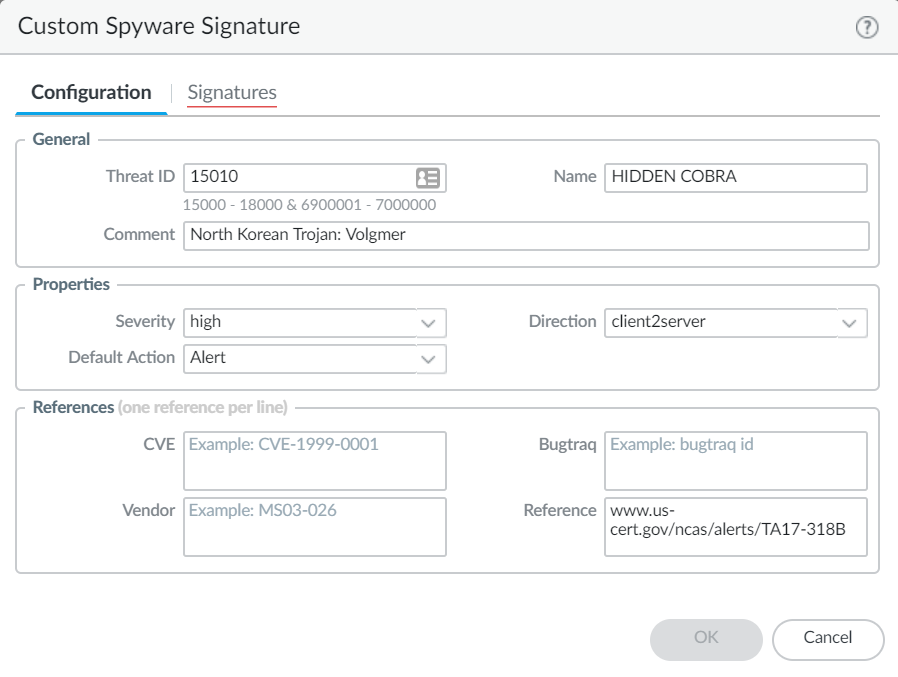Create a Custom Threat Signature from a Snort Signature
Table of Contents
Expand all | Collapse all
-
- About Custom Application Signatures
- Create a Custom Application Signature
- Create a Custom L3 & L4 Vulnerability Signature
- Test a Custom Signature
- Custom Signature Pattern Requirements
- Testing Pattern Performance Impact
-
-
- dhcp-req-chaddr
- dhcp-req-ciaddr
- dhcp-rsp-chaddr
- dhcp-rsp-ciaddr
- dns-req-addition-section
- dns-req-answer-section
- dns-req-authority-section
- dns-req-header
- dns-req-protocol-payload
- dns-req-section
- dns-rsp-addition-section
- dns-rsp-answer-section
- dns-rsp-authority-section
- dns-rsp-header
- dns-rsp-protocol-payload
- dns-rsp-ptr-answer-data
- dns-rsp-queries-section
- email-headers
- file-data
- file-elf-body
- file-flv-body
- file-html-body
- file-java-body
- file-mov-body
- file-office-content
- file-pdf-body
- file-riff-body
- file-swf-body
- file-tiff-body
- file-unknown-body
- ftp-req-params
- ftp-req-protocol-payload
- ftp-rsp-protocol-payload
- ftp-rsp-banner
- ftp-rsp-message
- gdbremote-req-context
- gdbremote-rsp-context
- giop-req-message-body
- giop-rsp-message-body
- h225-payload
- http-req-cookie
- http-req-headers
- http-req-host-header
- http-req-host-ipv4-address-found
- http-req-host-ipv6-address-found
- http-req-message-body
- http-req-mime-form-data
- http-req-ms-subdomain
- http-req-origin-headers
- http-req-params
- http-req-uri
- http-req-uri-path
- http-req-user-agent-header
- http-rsp-headers
- http-rsp-non-2xx-response-body
- http-rsp-reason
- icmp-req-code
- icmp-req-data
- icmp-req-type
- icmp-req-protocol-payload
- icmp-rsp-data
- icmp-rsp-protocol-payload
- icmp-req-possible-custom-payload
- ike-req-headers
- ike-rsp-headers
- ike-req-payload-text
- ike-rsp-payload-text
- imap-req-cmd-line
- imap-req-first-param
- imap-req-params-after-first-param
- imap-req-protocol-payload
- imap-rsp-protocol-payload
- irc-req-params
- irc-req-prefix
- jpeg-file-scan-data
- jpeg-file-segment-data
- jpeg-file-segment-header
- ldap-req-searchrequest-baseobject
- ldap-rsp-searchresentry-objectname
- ms-ds-smb-req-share-name
- ms-ds-smb-req-v1-create-filename
- ms-ds-smb-req-v2-create-filename
- msrpc-req-bind-data
- mssql-db-req-body
- netbios-dg-req-protocol-payload
- netbios-dg-rsp-protocol-payload
- netbios-ns-req-protocol-payload
- netbios-ns-rsp-protocol-payload
- nettcp-req-context
- oracle-req-data-text
- pe-dos-headers
- pe-file-header
- pe-optional-header
- pe-section-header
- pe-body-data
- pop3-req-protocol-payload
- pop3-rsp-protocol-payload
- pre-app-req-data
- pre-app-rsp-data
- rtmp-req-message-body
- rtsp-req-headers
- rtsp-req-uri-path
- sip-req-headers
- snmp-req-community-text
- smtp-req-argument
- smtp-rsp-content
- smtp-req-protocol-payload
- smtp-rsp-protocol-payload
- ssh-req-banner
- ssh-rsp-banner
- ssl-req-certificate
- ssl-req-chello-sni
- ssl-req-client-hello
- ssl-req-protocol-payload
- ssl-req-random-bytes
- ssl-rsp-cert-subjectpublickey
- ssl-rsp-certificate
- ssl-rsp-protocol-payload
- ssl-rsp-server-hello
- tcp-context-free
- telnet-req-client-data
- telnet-rsp-server-data
- udp-context-free
- unknown-req-tcp-payload
- unknown-rsp-tcp-payload
- unknown-req-udp-payload
- unknown-rsp-udp-payload
-
- dnp3-req-func-code
- dnp3-req-object-type
- dns-rsp-tcp-over-dns
- dns-rsp-txt-found
- ftp-req-params-len
- http-req-connect-method
- http-req-content-length
- http-req-cookie-length
- http-req-dst-port
- http-req-header-length
- http-req-param-length
- http-req-no-host-header
- http-req-no-version-string-small-pkt
- http-req-simple-request
- http-req-uri-path-length
- http-req-uri-tilde-count-num
- http-rsp-code
- http-rsp-content-length
- http-rsp-total-headers-len
- iccp-req-func-code
- ike-req-payload-type
- ike-rsp-payload-type
- ike-req-payload-length
- ike-rsp-payload-length
- ike-version
- imap-req-cmd-param-len
- imap-req-first-param-len
- imap-req-param-len-from-second
- irc-req-protocol-payload
- irc-rsp-protocol-payload
- open-vpn-req-protocol-payload
- pfcp-req-msg-type
- pfcp-rsp-msg-type
- smtp-req-helo-argument-length
- smtp-req-mail-argument-length
- smtp-req-rcpt-argument-length
- sctp-req-ppid
- ssl-req-client-hello-ext-type
- ssl-req-client-hello-missing-sni
- ssl-rsp-version
- stun-req-attr-type
- panav-rsp-zip-compression-ratio
- Context Qualifiers
-
Create a Custom Threat Signature from a Snort Signature
Convert a third-party signature a custom PAN-OS threat
signature.
The following steps illustrate the process
for converting a Snort signature into a custom spyware signature
compatible with Palo Alto Networks firewalls. The use case below
uses a Snort rule for a North Korean Trojan malware variant as identified
by the Department of Homeland Security, the Federal Bureau of Investigation,
and other US government partners.
With Panorama version 10.0
or later, you can use the IPS Signature Converter plugin to automatically
convert Snort and Suricata rules into custom Palo Networks threat
signatures instead of manually performing the following procedure.
Snort
rule:
alert tcp any any -> any any (msg:"Malformed_UA"; content:"User-Agent: Mozillar/"; depth:500; sid:99999999;)
In
this example you can:
- Use the IP addresses provided as part of the IOC List to detect if a possible infection already exists by searching the firewall logs.
- The IP addresses provided can be part of an EDL or Address group and added to a Policy to block traffic to and from the suspicious list.
- Use the provided Snort signature and convert it to a custom spyware signature. This signature will become part of the spyware profile added to the appropriate policy.
For
other use cases, see our companion article.
- Create a Custom Spyware Object.
- Navigate to.ObjectsCustom ObjectsSpyware/Vulnerability
- ClickAddand provide aThreat ID, an optional comment, and fill out the Properties section.
![]()
- UnderSignatures, pressAdd.
- Specify the following information:
- Standard—Enter a name to identify the signature in the field.
- Comment—Enter an optional description.
- If the order in which the firewall attempts to match the signature definitions is important, keepOrdered Condition Matchselected.
- Scope—Indicate whether this signature applies to a fullSessionor a singleTransaction.
- Add a condition by clickingAdd And ConditionorAdd Or Condition.
- Select anOperatorfrom the drop-down menu to define the conditions that must be true for the signature to match traffic.
- If you selectPattern Match, identify aContextin the Snort pattern that matches our available contexts, provide a regular expressionPattern, and optionally,Adda qualifier/value pair. SelectNegateto specify conditions under which the custom signature does not trigger.
- If you selectEqual To,Less Than, orGreater Than, select aContextand enter aValue.
- ClickOKto finish creating the Spyware object.
- Verify that the custom Spyware object is part of your Anti-Spyware Profile.
- Go to. Click an existing profile, then underSecurity ProfilesAnti-SpywareExceptions, search for your signature’s Threat ID andEnableit.
- Create an EDL object.
- Navigate to. ClickObjectsExternal Dynamic ListsAdd.
- Add the suspicious IP address provided from the IOC list to a previously created EDL or a new EDL as shown below.
- Add the EDL and Anti-Spyware profiles to appropriate Policy Objects.
- Test policy is working as expected by looking at Threat logs.
- Change the action for the spyware object from alert to drop/reset after verification. Also, change the severity of the object created as needed.
- Commityour signature(s).

